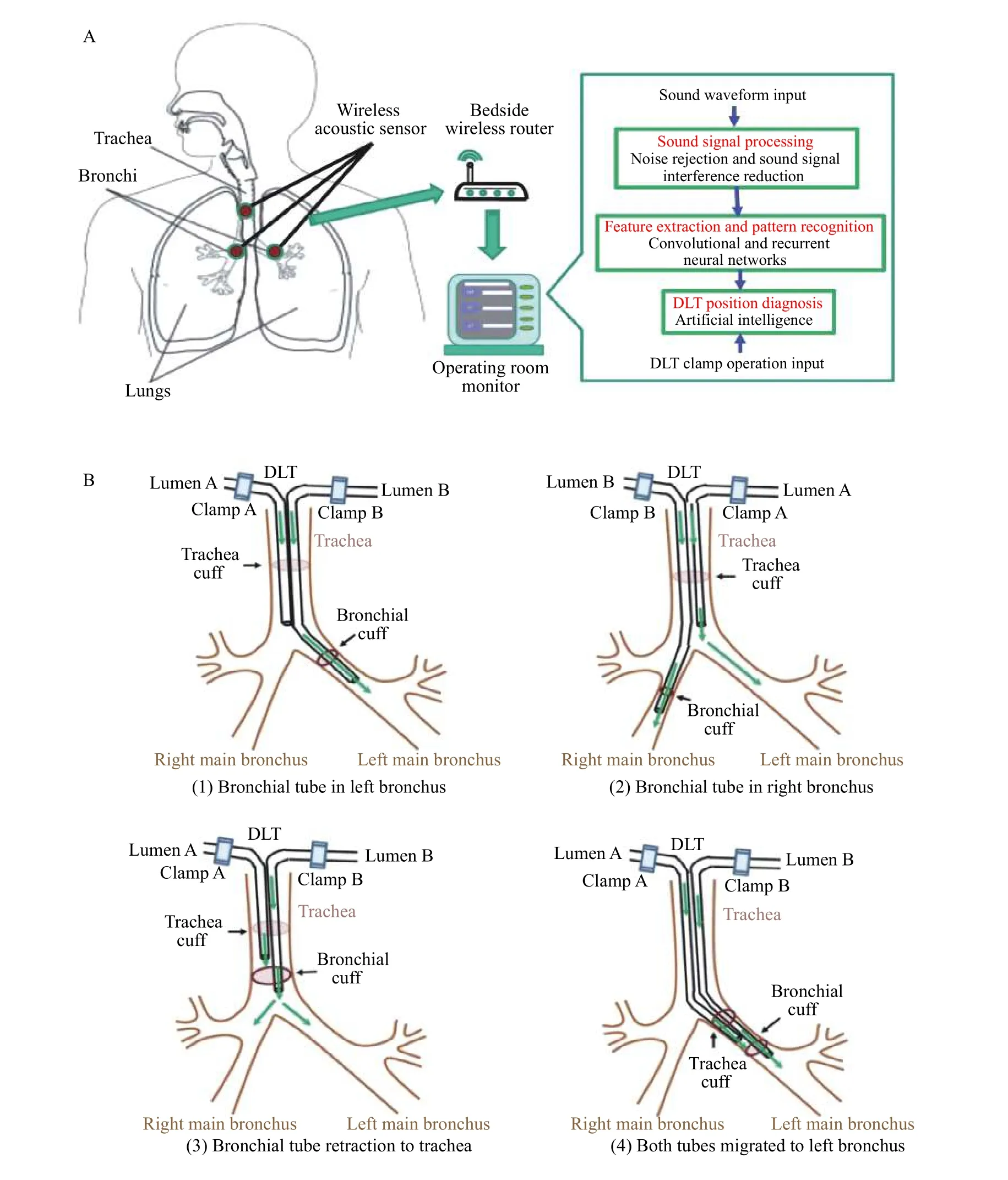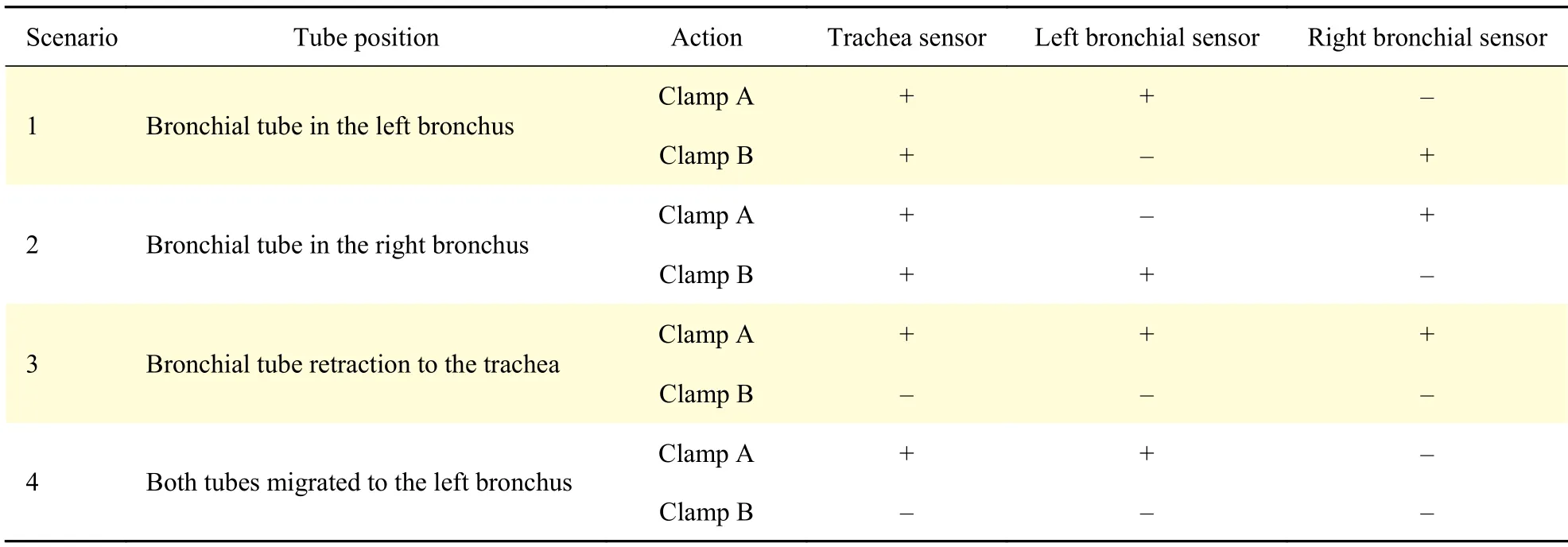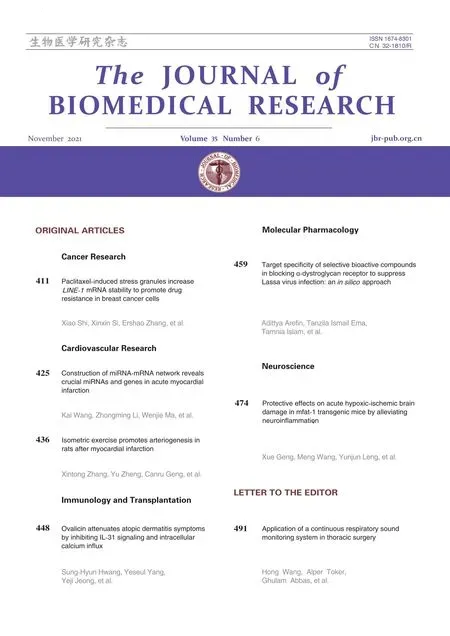Application of a continuous respiratory sound monitoring system in thoracic surgery
2021-12-04HongWang,AlperToker,GhulamAbbas等
Dear Editor,
We would like to present a novel system for monitoring double-lumen tube (DTL) positions in thoracic surgery by respiratory sounds at the trachea and the bronchi, based on our previously described methodology, algorithms, and patented technology[1–2].
Most thoracic surgeries require one-lung ventilation(OLV). A DLT or a bronchial blocker (BB) is the most common means for managing OLV.Intraoperative DLT or BB malposition is a critical issue that needs to be accurately and promptly detected to prevent the incidence of hypoxemia and unintended re-expansion of operated lung during OLV[3–4]. A multi-center study of 2127 patients requiring OLV during thoracic surgery revealed that DLTs were used in 95% of patients with a malposition rate of 14%, and BBs were used in 5% of patients with a malposition rate of 33%[5].
The current standard practice uses a fiberscope to confirm the double lumen position at the time of placement, after changing of the patient positions such as from supine to lateral, and intermittently during the procedure especially when there is a change in patient's airway pressure and/or oxygen concentration.This technology is reliable, but it is intermittent and invasive. Noninvasive, continuous, automated, and reliable monitoring of DLT positions is needed to prevent the hypoxemia and unintended re-expansion of operated lung due to the endobronchial malposition. Such a device can supplement the current practice of using fiberscope and substantially enhance diagnostic and monitoring capabilities in operating rooms, and improve healthcare safety and quality.
Due to the rapid development of digital stethoscope technology, continuous auscultation of the upper respiratory tract has become a feasible technological innovation that can potentially improve DLT accuracy and safety. To address the noise corruption and signal interference issues, we have developed a multi-sensor signal separation algorithm[2,6–8]. Furthermore, signal processing methods have been employed for pattern recognition and feature extraction in respiratory sounds[2]. These technical foundations have paved the way to realize a new DLT monitoring technology in thoracic anesthesia.
This DLT monitoring technology involves a sensing system that consists of multiple sound sensors, a communication or interfacing device to connect the sensors to an operating room monitor, and a smart software system for sound processing methods and algorithms that perform the tasks of sound signal processing, feature extraction, and diagnosis of DLT positions. A concept scheme of such a system and its usage is shown inFig. 1.

Fig. 1 Smart double-lumen tube monitoring system. A: Monitoring system. B: DLT position scenarios. DLT: double lumen tube; Lumen A: endotracheal lumen; Lumen B: endobronchial lumen.
Digital stethoscopes have high sound qualities. By combining a well-designed acoustic chamber with electronic signal amplifier in their sensor heads,digitalized sound signals can be created with high fidelity. Sound quality is in proportion to the size of digital stethoscopes. As a result, current commercial digital stethoscopes are bulky and designed for handheld usage. Miniature sound sensors have been developed for diverse applications. Such sensor technologies can be adopted for clinical applications so that they become small in size, flexible and secure for attachment to skins, integrated with wireless communication capability, and sensitive and robust in ensuring sound qualities. Electroencephalogram (EEG),electrocardiogram (EKG), and bispectral index sensors provide basic guidelines on the needed sensor types.
Currently, most clinical sensors are connected to processing devices by wired connections, as exemplified by EEG and EKG sensors. It is expected that the first generation of the DLT monitoring sensors may follow the same guidelines by using wired connection for secured and high-quality signal transmission. However, a desirable direction is to employ wireless connections so that the monitoring system will have minimum interference with thoracic surgeries. Technology for utilizing wireless links in this application is mature and no real obstacles are expected.
The success of the DLT monitoring technology relies critically on sound processing systems for ensuring prompt, accurate, and reliable detection of DLT malposition. The sound processing system consists of the following function modules:(1)Extraction of high-fidelity sound signals.Airflow sounds in the trachea and the bronchi are small and can be easily corrupted and overwhelmed by environmental noise in an operating room. This module removes noise from sound waveforms[4–7].(2)Feature and pattern extraction.Due to large variations in patient conditions, surgery types, tube designs, and tube placement, sound wave forms vary significantly. Accurate feature and pattern extraction is a key requirement for reliable DLT monitoring.Artificial intelligence (AI) methodologies using neural networks are uniquely suitable for treating sound signals and extracting useful patterns. (3)DLT position diagnosis.This is a decision module for identifying DLT positions. Relying on the main patterns extracted from the AI-based algorithms, a computerized decision system can be developed by using machine learning algorithms.
Acoustic sensors are placed on the skin at the related DLT locations at the trachea and the bronchi(Fig. 1). The sensing mechanism, signal amplifier,and wireless transmitter are integrated in the sensors.The sound signals are transmitted wirelessly to the bedside router. Since the router is very close to the sensors, it allows low-power transmission to save battery electricity on the sensors. The router relays the sound signals with amplified power to the operation room minor for processing, in which the smart DLT position monitoring system is embedded.
The DLT position monitoring system can continuously detect tube position by using sound strength in the trachea and the bronchi. When the airflow rate is normal, the respiratory sound strength is high. In contrast, when a tube is misplaced or moves to a wrong position, the airflow rate reduces or terminates, and the corresponding respiratory sound strength diminishes or disappears. For example, the following common scenarios of tube misplacement and related sound strength are listed inTable 1and illustrated inFig. 1.

Table 1 Double-lumen tube positions and sound features
In summary, the smart continuous DLT position monitoring system outlined in this letter is a promising and valuable tool for enhancing safety.Recent advancement in sensor technology, signal processing techniques for obtaining authentic sound signals, neural networks methods for pattern extraction, and artificial intelligence and machine learning algorithms for decision making, has made this new monitoring system a feasible device to supplement bronchoscopes. As a new technology,reliability, accuracy, cost, and its seamless integration with the current practice will be important next steps.
Yours Sincerely,
Hong Wang1,✉, Alper Toker2, Ghulam Abbas3,Le Yi Wang4
1Department of Anesthesiology,
2Department of Cardiovascular and Thoracic Surgery,
3Department of Thoracic Surgery,
West Virginia University,
Morgantown, WV 26506,
USA;
4Department of Electrical and Computer Engineering,Wayne State University,
Detroit, MI 48202,
USA.
✉Tel/Fax: +1-304-598-4122/+1304-598-4930,
E-mail: hong.wang1@wvumedicine.org.
RECEIVE IMMEDIATE NOTIFICATION FOR EARLY RELEASE ARTICLES PUBLISHED ONLINE
To be notified by e-mail whenJournalearly release articles are published online, sign up at jbr-pub.org.cn.
杂志排行
THE JOURNAL OF BIOMEDICAL RESEARCH的其它文章
- Protective effects on acute hypoxic-ischemic brain damage in mfat-1 transgenic mice by alleviating neuroinflammation
- Target specificity of selective bioactive compounds in blocking α-dystroglycan receptor to suppress Lassa virus infection: an in silico approach
- Ovalicin attenuates atopic dermatitis symptoms by inhibiting IL-31 signaling and intracellular calcium influx
- Isometric exercise promotes arteriogenesis in rats after myocardial infarction
- Construction of miRNA-mRNA network reveals crucial miRNAs and genes in acute myocardial infarction
- Paclitaxel-induced stress granules increase LINE-1 mRNA stability to promote drug resistance in breast cancer cells
